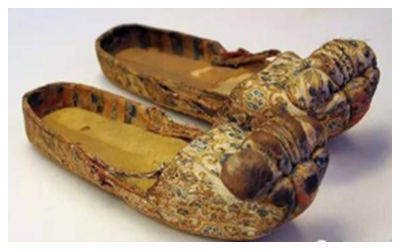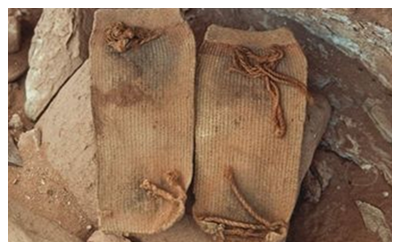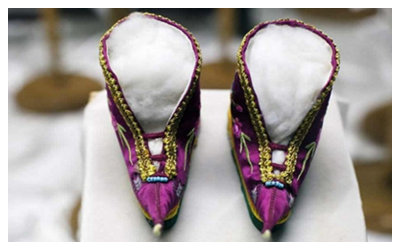In the Neolithic age (from about 10,000 years ago to about 4,000 year ago), ancestors of China used grass, hemp, or kudzu vine to make shoes. There were many ways to name shoe, such as Jü, Lü, Xi and so on. Xi is the most valuable. Ancient Chinese shoes were classified into three types in terms of material, i.e. grass, cloth and leather. Cloth shoes refer to shoes made with hemp fiber, damask silk, brocade and so on.
Xi, Ancient Chinese Shoes

In the Han Dynasty (206 BC-23 AD), the toe cap of cloth shoe was usually biforked, and the tread was made with linen thread. Such a shoe was called "Shuangjian Qiaotou Fanglü (square shoe with double tips and a rising head).
In the Wei and Jin Dynasties (220-316), the front tip of a shoe was usually decorated with a double-beast pattern. The color matching was harmonious, and the whole shoe looked very graceful.
In the Northern Song Dynasty (550-577), Ji was popular among all people, from the emperor to common people. The so-called Ji was a shoe with wooden teeth and consisted of three parts: Bian (the shoe body), Xi (the lace) and Chi (the teeth).
In the Song Dynasty (960-1297), most men wore leather shoes with a small toe, and women usually wore shoes with a round toe, flat toe or rising toe, sometimes decorated with various patterns such as flower or bird.
In the Ming Dynasty (1368-1644), men's shoes usually stressed thickness and strength, and the materials and fashions were varied. In general, in the north people wore lozenge-patterned good-looking shoes, and in the south people wore palm fiber shoes. Besides, in the period from the Yuan Dynasty (1271-1368) to the Ming

Dynasty, a kind of female cloth shoes was popular, which was characterized by a high rising toe and a flat and thick tread. It made its wearers especially slim.
Jixie, Ancient Chinese Slippers
In China, sandals evolved from slippers. Slippers, called "Jixie" in ancient times, originated in the Han Dynasty (206BC-23AD). Subsequently, hemp sandals, cloth sandals and leather sandals appeared one after another. The ancient people embroidered some auspicious patterns, such as dragon and phoenix, etc., on their sandals. Some even decorated them with jewels.
Double-ridged shoes

In the Qing Dynasty (1644-1911), men's shoes were mostly pointed-toe ones, whose materials were satin in summer and autumn, and lint in winter. The tread might be thick or thin, the instep might be single-ridged or double-ridged, and the upper might have embroidery, or there was a pattern of cirrus clouds at the toe. Women's shoes in the Qing Dynasty were very special: the tread was usually wooden and in the shape of a horse's roof, as high as one to five inches , so it was called "Matidi" (horse hoof shaped tread). The instep was usually made of silk, with colored embroidery on it. Those worn by noble women also had some jewelry inlaid on the vamp. Old women usually wore wooden flat-soled shoes.
Opinions vary about the origin of high-heeled shoes. It is said to originate from China. There were already high-heeled wooden sandals as early as the Three Kingdoms Period (220-280). Some Qixie (
Manchu shoes) worn by
Manchu women in ancient times, had a heel higher than five Cun.
Boots, used to be worn by the nomadic nationalities in north China, are also called "ridding boots" and "high boots". There are many kinds of boots: Hanxue (dry land boots), Huaxue (colored boots), leather boots, felt boots, unlined boots, cotton boots, Yuntouxue (boots with cloud patterns at the toe), Edingxue (boots with a goose-shaped toe) and so on.
In the Northern and Southern Dynasties (420-581), boots were popular in the north, and even spread to the south. In the Tang Dynasty (618-907), boots were worn by both officials and common people. In the Song Dynasty, boots for females began to appear. In the Yuan Dynasty, Korean-style boots prevailed. In the Ming Dynasty, although the court forbad common people to wear boots, there were still many short boots, which looked like both shoes and boots. Men in the
Qing Dynasty usually wore shoes, and only wore boots to match official uniforms. Materials of boots mostly were satin, lint, cloth and leather. Chaoxue (boots for the court) had a square toe, but boots for common people had pointed toes.
 Chinese footbinding
Chinese footbinding
According to experts on folklore, Chinese footbinding originated in the Southern Tang Dynasty (937-976). The so-called "three-inch golden lotuses" refer to women's tiny bound feet, and also refer to the shoes they wore: they were in the shape of a rising bird head. Their treads were wooden, in a bent shape like a bow. Therefore, they were called "bow shoes", which originally meant bent-tread shoes, but later generally referred to the small shoes worn by foot-bound women.
In the Yuan and Ming Dynasties, there was a rule that footbinding was permitted only for women from noble families. The bow shoes of that time had treads as high as 4 - 5 Cun. By the
Qing Dynasty, "three-inch golden lotuses" worn by the
Han women had won the favor of the Manchu women. The
Qing court issued orders many times to prohibit Manchu people from footbinding, but still many Manchu women liked to follow it. Threfore, footbinding became very popular among them. There are various kinds of bow shoes: sleeping shoes, Huanjiaoxie (shoes for change of feet), sharp-crested shoes, Tatangxie (shoes for walking in the main room), net shoes, lotus shoes, overshoes, funeral shoes, female shoes, and so on. The exquisite bow shoes had various kinds of embroidered patterns at the toe, the tread, the inside and the upper. Rich women's bow shoes even had some bright pearls or other ornaments on them.

 In the Han Dynasty (206 BC-23 AD), the toe cap of cloth shoe was usually biforked, and the tread was made with linen thread. Such a shoe was called "Shuangjian Qiaotou Fanglü (square shoe with double tips and a rising head).
In the Han Dynasty (206 BC-23 AD), the toe cap of cloth shoe was usually biforked, and the tread was made with linen thread. Such a shoe was called "Shuangjian Qiaotou Fanglü (square shoe with double tips and a rising head). Dynasty, a kind of female cloth shoes was popular, which was characterized by a high rising toe and a flat and thick tread. It made its wearers especially slim.
Dynasty, a kind of female cloth shoes was popular, which was characterized by a high rising toe and a flat and thick tread. It made its wearers especially slim. In the Qing Dynasty (1644-1911), men's shoes were mostly pointed-toe ones, whose materials were satin in summer and autumn, and lint in winter. The tread might be thick or thin, the instep might be single-ridged or double-ridged, and the upper might have embroidery, or there was a pattern of cirrus clouds at the toe. Women's shoes in the Qing Dynasty were very special: the tread was usually wooden and in the shape of a horse's roof, as high as one to five inches , so it was called "Matidi" (horse hoof shaped tread). The instep was usually made of silk, with colored embroidery on it. Those worn by noble women also had some jewelry inlaid on the vamp. Old women usually wore wooden flat-soled shoes.
In the Qing Dynasty (1644-1911), men's shoes were mostly pointed-toe ones, whose materials were satin in summer and autumn, and lint in winter. The tread might be thick or thin, the instep might be single-ridged or double-ridged, and the upper might have embroidery, or there was a pattern of cirrus clouds at the toe. Women's shoes in the Qing Dynasty were very special: the tread was usually wooden and in the shape of a horse's roof, as high as one to five inches , so it was called "Matidi" (horse hoof shaped tread). The instep was usually made of silk, with colored embroidery on it. Those worn by noble women also had some jewelry inlaid on the vamp. Old women usually wore wooden flat-soled shoes. Chinese footbinding
Chinese footbinding  Ask Questions ?
Ask Questions ?